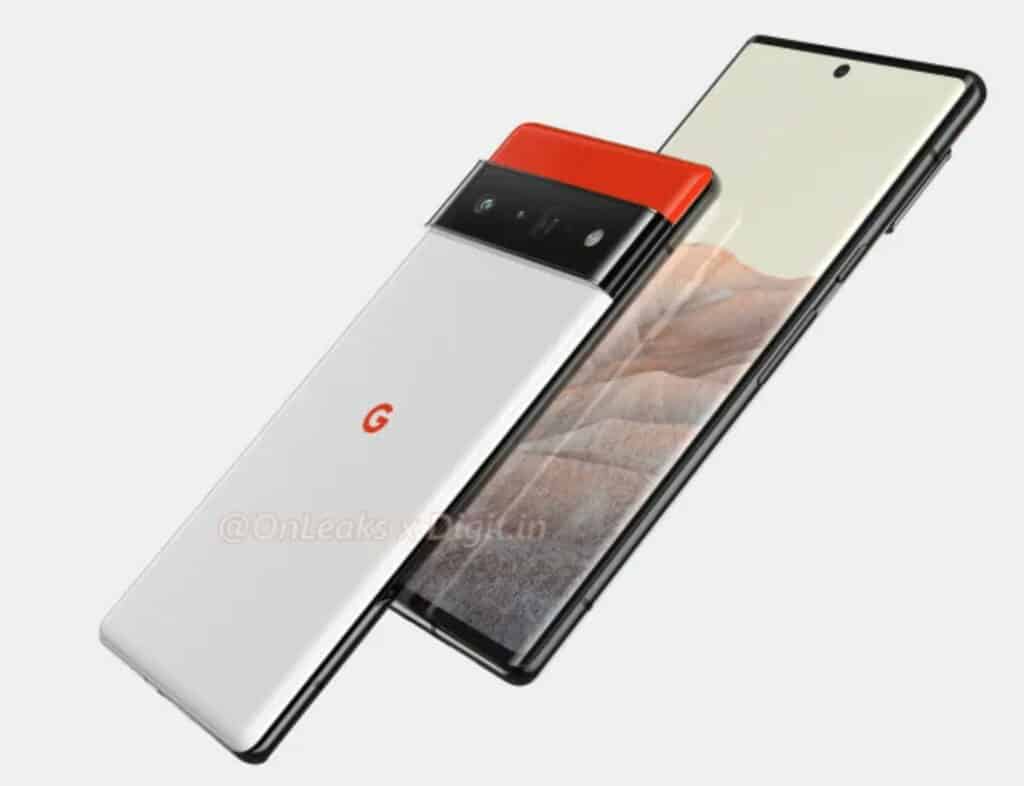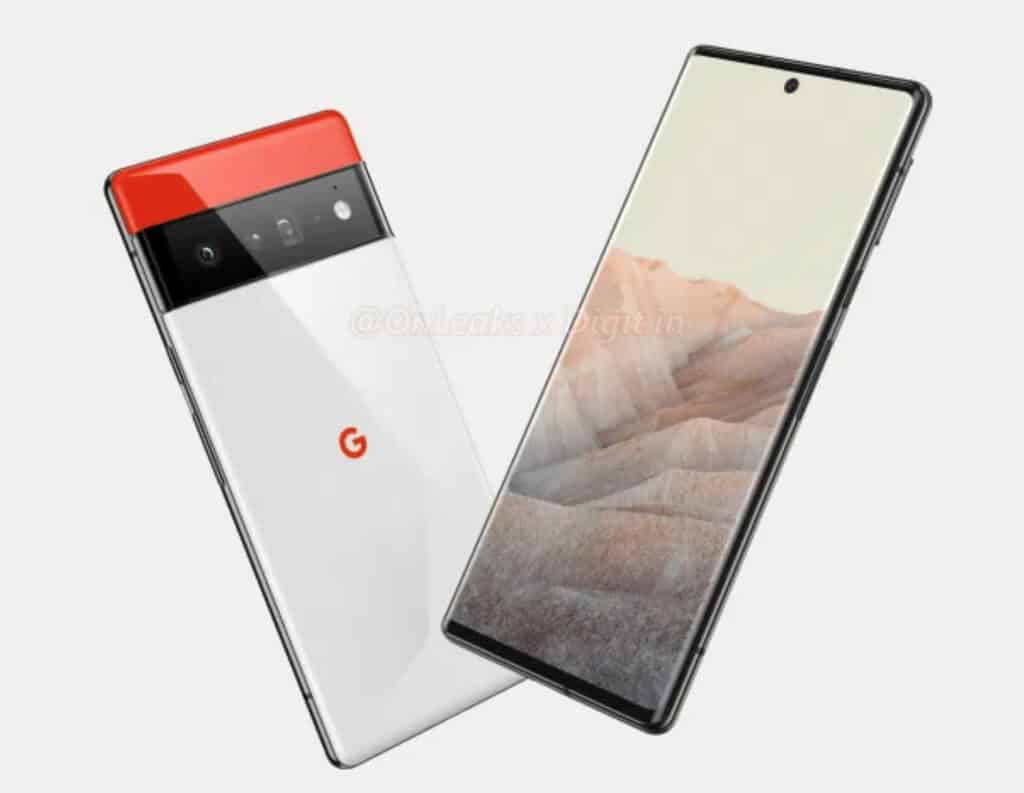The Google Pixel 6 – and Pixel 6 Pro – will be something of a departure from last year’s Pixel 5. The phone is bigger, more interesting to look at, and will run higher-end specs – here’s everything you need to know…
The Google Pixel 5 was a great phone. Still is, in fact. I’ve been using one since it first came out and it hasn’t missed a beat. For me, it is the best Pixel phone Google has made to date.
But in 2021, we’ll see two distinctly different phones from Google in the form of the Pixel 6 and the Pixel 6 Pro.
The Pixel 6 and Pixel 6 Pro look dramatically different. They’ll carry vastly better spec and hardware. And there will be significant updates to the camera.
If you’re interested in picking up a new Pixel later this year, read on as we detail everything you need to know about Google’s incoming Pixel 6 phones…
Google Pixel 6 Design

Pixel 6 Size & Dimensions
- Dimensions: 158.60 x 74.80 x 8.90mm
- Display Size: 6.4-inch display
Pixel 6 Pro Size & Dimensions
- Dimensions: 163.9 x 75.8 x 8.9mm
- Display Size: 6.67-inch display
Google’s industrial design on the Pixel phones to date has been extremely conservative. Save for the Pixel 3 XL, none of its Pixel phones have had any real “design” quirks on them – they’ve been safe and by the numbers.
And that’s fine. Boring is good.
On the Pixel 3a, Pixel 4a, and Pixel 5, it worked wonders, scoring Google legions of new users.
By dialing back the design and focussing on performance and utility, Google solidified its Android phones as viable alternatives to iPhone and Samsung.
The Pixel 6 (and Pixel 6 Pro) then is something of a departure. The design is definitely louder and more engaging. It features a raised camera module on the rear topped by a red accent at the top of the back panel.
As you can see in the images above, it is certainly an eye-catching design. It pulls you in, the use of red accents creates extreme contrast and, like the camera module on the Galaxy S21 Ultra, it really works – and looks a tad retro (which I like).
The front of the Pixel 6 is less exciting. It is mostly display with a small hole-punch camera located in the middle at the top. You have a power and volume rocker on the right side of the phone.
One element missing, however, is a fingerprint sensor. Could this mean that the Pixel 6 will not feature a physical fingerprint sensor? It’s entirely possible, although the leaked images above could be wrong.
If the leaked images are legit, and the Pixel 6 does not have a fingerprint sensor, then it will either use an in-screen fingerprint sensor or, like Apple’s iPhone 12, simply use facial recognition instead.
I really like having the physical fingerprint scanner on my Pixel 5; it is located on the back and is easy to access. I don’t know how I feel about its removal, to be honest. I just hope Google has nailed facial recognition if the fingerprint sensor has been nixed.
Google Pixel 6 Specs – What We Know So Far…
What are the specs like inside Google’s Pixel 6 and Pixel 6 Pro? As I noted in the introduction, these phones will be higher-specced and feature more “impressive” specs that the outgoing Pixel 5.
Here’s a comparison of how the Pixel 6 and Pixel 6 Pro’s specs compare.
| SPECS | PIXEL 6 | PIXEL 6 PRO |
|---|---|---|
| DISPLAY | 6.4-inch, Full HD+, 120Hz | 6.67-inch, Quad HD+, 120Hz |
| DIMENSIONS | 158.6 x 74.8 x 8.9mm | 163.9 x 75.8 x 8.9mm |
| CPU | Google Custom CPU | Google Custom CPU |
| RAM | 8GB | 8GB – 12GB |
| CAMERAS | Dual-Lens (50MP Main) | Triple Lens (50MP Main + Telephoto) |
| BATTERY | 5000mAh | 5500mAh |
| STORAGE | 64GB & 128GB | 128GB, 256GB, 512GB |
One of the most scintillating rumors about Google’s Pixel 6 phones is that they could well be the first phones to run Google’s own custom chipsets.
Like Apple, Google wants to develop and build-out its own silicon, it has made no bones about this in the press. And given how successful Apple has been, the move would appear to make sense.
Details about Google’s own CPU are pretty scant at the moment. Reports suggest that its performance will sit somewhere between the Snapdragon 875 and the Snapdragon 888.
Along with the Whitechapel SoC, Google’s leaked documents make mention of “Slider,” which is believed to be the shared platform for the first Whitechapel devices. There are also references to Samsung associated with Slider, which backs up previous claims that Samsung was working with Google on the project. It sounds like Whitechapel is going through Samsung’s large-scale integration (LSI) division, suggesting it will share some features with Samsung’s Exynos chips.
ExtremeTech
With memory (RAM), it’s a similar story – no one has any concrete data on this aspect of the phones. But given the competition and Google’s track-record, I’d assume we’ll see 8GB in the Pixel 6 and perhaps 12GB at a push in the Pixel 6 Pro model.
With battery life, the standard Pixel 6 will run a 5000mAh battery. The Pixel 6 Pro is a larger phone with a bigger display, so it stands to reason that it will run a slightly larger battery – perhaps 5500mAh or thereabouts.
Both phones will run 5G, of course, but the speeds that they will be able to access will depend on the modem Google uses. And that will depend on the chipset that the phones run. And we currently don’t know whether the Pixel 6 will run Qualcomm or Google’s new custom chipset.
Pixel 6 Camera Update
With cameras on the Pixel 6, things, again, are slightly different to how Google has traditionally done things. The first big difference is that Google is differentiating the phones – the Pro model will have a better camera.
The Pixel 6 Pro will run a triple-lens camera, while the Pixel 6 will run a dual-lens camera module. Both phones will run a 50MP main camera and an ultra-wide lens. But the Pixel 6 Pro will feature an additional 8MP telephoto lens.
Reports have also claimed that the Pixel 6 / Pixel 6 Pro’s front-facing camera will be able to shoot 4K video as well. Nothing has been officially confirmed as yet. But given what we’ve heard from our sources, these camera details seem fairly plausible given what the competition is doing right now.
Wrapping Up…
As you can see, the Pixel 6 and Pixel 6 Pro are two markedly different phones. They’re different from one another and they’re different from what came before (the Pixel 5).
Google has tweaked the design massively, it is fitting both phones with larger displays, and the cameras have been updated significantly – a 50MP camera on a Pixel phone is basically heresy. And I dig it.
The Pixel 5 did not look like a flagship phone and it wasn’t priced like one either. Google’s two-year stint on value for money over fancy specs earned it plenty of new users, but it would appear this stint is now over.
The Pixel 6 and Pixel 6 Pro look and sound a lot like flagship phones which means they’ll likely retail from anywhere from $800 to $1000, respectively. The Pixel 5a will presumably be Google’s value proposition.
And that’s cool, I like that split – it makes sense. With the Pixel 6, Pixel 6 Pro, and the Pixel 5a, Google has effectively covered all the bases. Providing the Pixel 6 and Pixel 6 Pro hits the mark, I can see plenty of people switching to Pixel later on this year.
I know I’ll be using these phones, most likely the Pixel 6 Pro given its updated camera and larger display.





